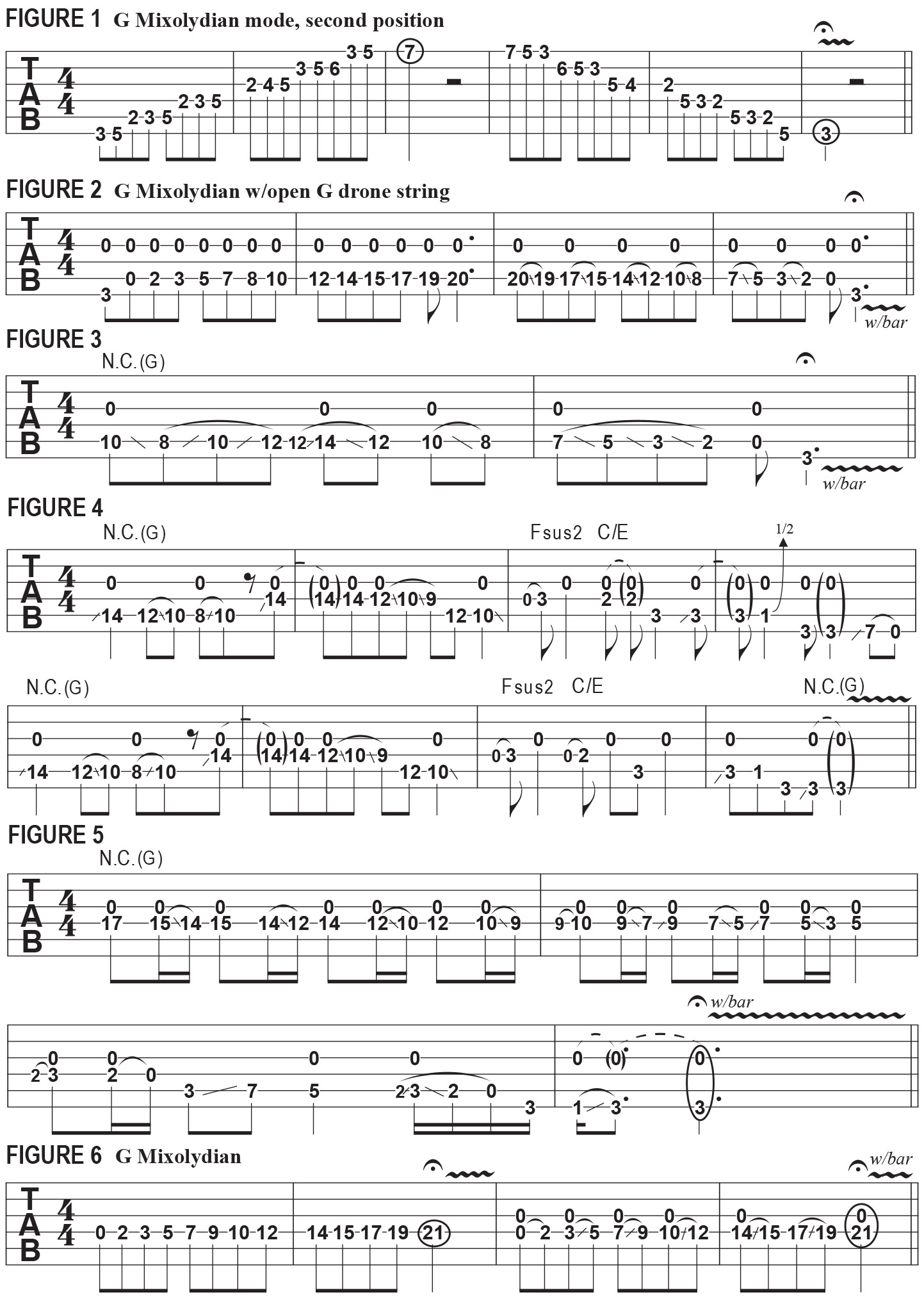Utilizing Open-String Drones for Single-Note Licks, Melodies and Solos
Incorporating the use of an open string as a “drone” within licks and solo lines is a great, creative way to establish the sound of harmony while playing a single-note phrase. Drones figure prominently in Indian classical music, as heard on instruments such as the sitar and sarod.
The concept is simple: while a melody is played up and down one string, an additional open string (or strings) is sounded simultaneously, most often serving to establish a reference to the tonic, or “one” chord, which represents the home key of the piece of music.
On electric guitar, the strings used most often for drone-type licks are the open low E and A, but I’d like to kick things off with utilizing the open G string as our drone, and the lines played around it will be in the key of G, establishing the G note as our tonic. The next choice to make is to decide what scale to base your melody on, so let’s begin with the G Mixolydian mode (G A B C D E F), which alludes to the sound of a G7 (dominant) chord.
This is an easy mode to remember because there are no sharps or flats; G Mixolydian also comprises the same seven notes as the C major scale (C D E F G A B).

FIGURE 1 illustrates G Mixolydian played in second/third position, ascending and descending. Let’s apply the drone-string concept by picking each note of the G Mixolydian mode, as fretted on the A string, simultaneously with the open G note, as demonstrated in FIGURE 2: the constant presence of the G tonic serves to clearly depict the sound and quality of each of the intervals in G Mixolydian, so focus on the sound of A, the second, against the G tonic, as well as B, the third, C, the fourth, D, the fifth, etc.
FIGURE 3 offers an example of a simple melody, played utilizing the drone-string concept: starting on a fretted G note, the line moves down to F and then back up the mode through each scale degree to the major third, and then back down through the entire mode, articulating the movement among the various pitches with slides.
FIGURE 4 offers a more complex melody played against the open G-string drone, with the harmony expanded to include reference to different chords in bars 3 and 4, and in bars 7 and 8. In these bars, an F note is used against the open G to reference Fsus2, and an E note is used to imply C/E (a C chord over an E bass note, or “C over E”).
Now let’s move the Mixolydian mode onto another string. As shown in FIGURE 5, G Mixolydian is played in a descending melodic fashion on the D string while the open G is sounded simultaneously. FIGURE 6 shows the mode in its single-note form, as well as in conjunction with the open G-string drone.
Next time, I’ll show you more interesting and useful ways to incorporate the drone-string concept into solos and melodic phrases.
Get The Pick Newsletter
All the latest guitar news, interviews, lessons, reviews, deals and more, direct to your inbox!
Guitar World Associate Editor Andy Aledort is recognized worldwide for his vast contributions to guitar instruction, via his many best-selling instructional DVDs, transcription books and online lessons. Andy is a regular contributor to Guitar World and Truefire, and has toured with Dickey Betts of the Allman Brothers, as well as participating in several Jimi Hendrix Tribute Tours.








![Joe Bonamassa [left] wears a deep blue suit and polka-dotted shirt and plays his green refin Strat; the late Irish blues legend Rory Gallagher [right] screams and inflicts some punishment on his heavily worn number one Stratocaster.](https://cdn.mos.cms.futurecdn.net/cw28h7UBcTVfTLs7p7eiLe.jpg)


